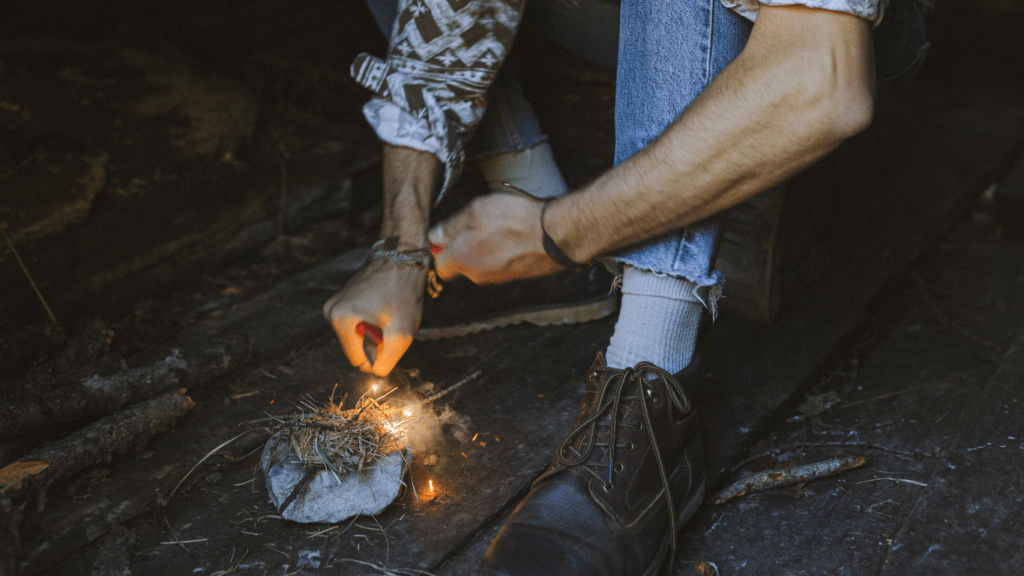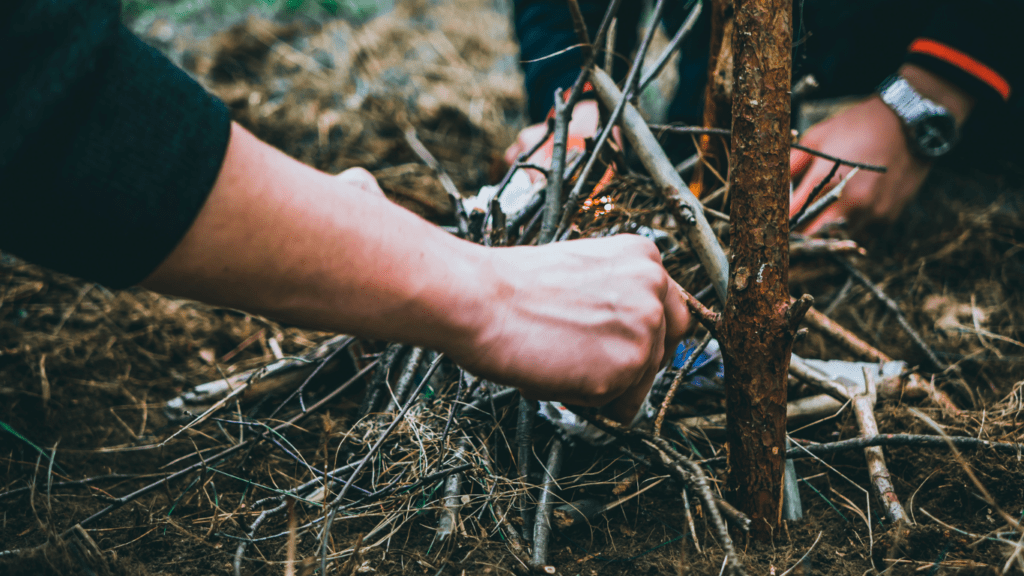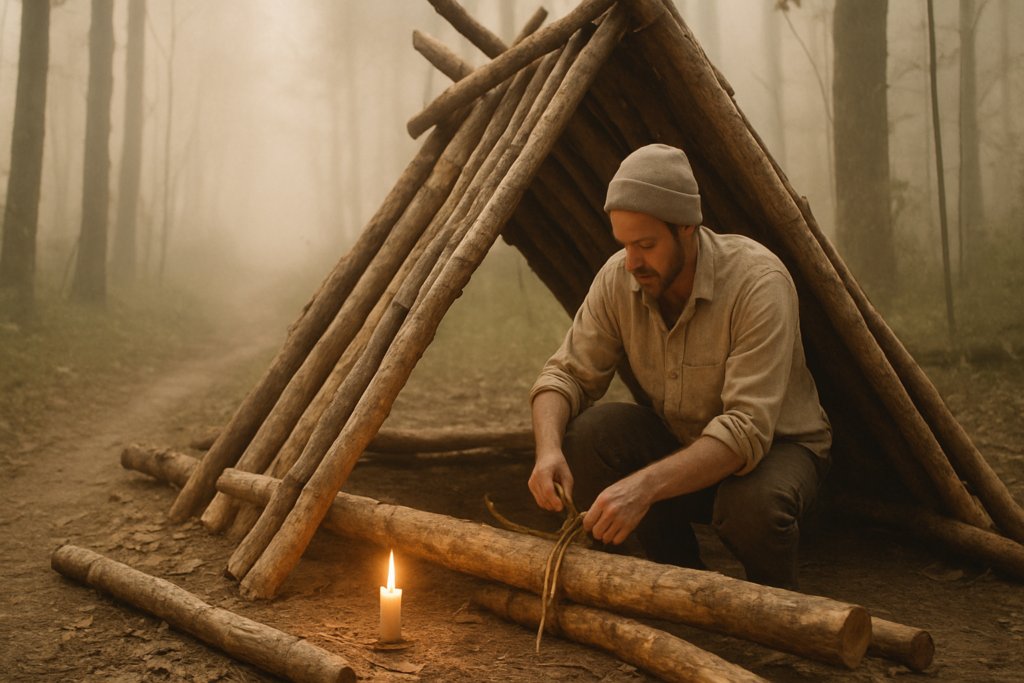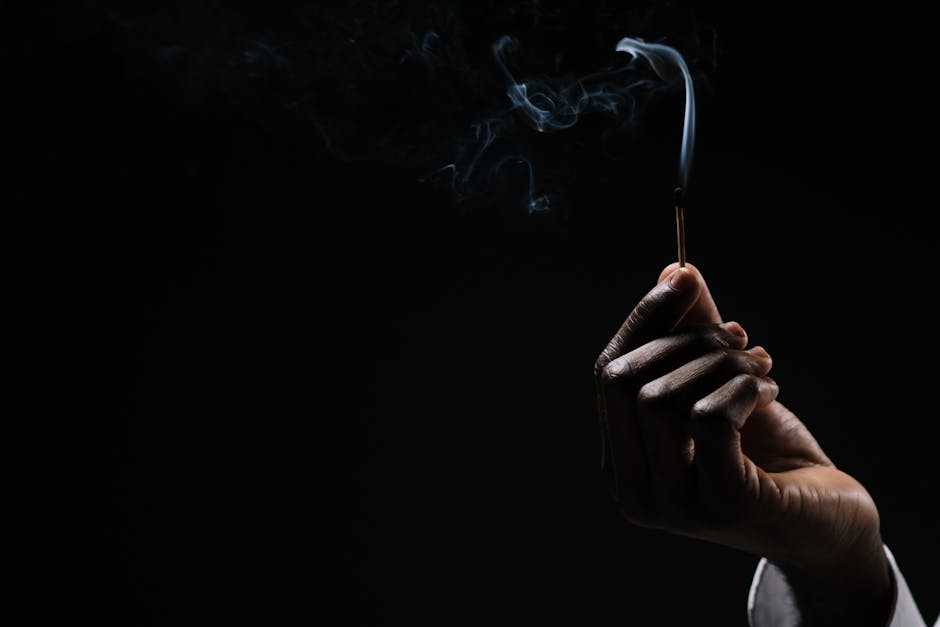Importance Of A Fire-Starting Kit
A fire-starting kit is critical for survival in the forest. Fire provides warmth, cooks food, and purifies water. It can signal for help and keep predators at bay. Without a reliable way to start a fire, these functions are compromised, putting safety and well-being at risk.
Temperature regulation is essential, especially in cold climates. Hypothermia can set in quickly without proper clothes and shelter. A fire mitigates this risk by providing consistent heat. This is particularly vital during the night when temperatures drop and maintaining warmth becomes crucial.
Cooking food ensures proper nutrition and energy. Raw food can harbor bacteria and parasites, posing health risks. Starting a fire means I can boil water to make it safe for drinking, reducing the threat of waterborne diseases. Fire sterilizes water, making it essential for hydration.
Signaling for help is another key aspect. In an emergency, thick smoke from a fire is more visible than other signals. It’s an effective way to draw attention and expedite rescue operations. Predators generally avoid fire, offering a layer of protection during night hours.
A fire-starting kit boosts confidence and preparedness. Knowing I have the means to address basic survival needs reduces anxiety. It instills a level of self-sufficiency that enhances overall forest survival skills. Each item in the kit, from tinder to ignition sources, serves a critical function.
Having a fire-starting kit is not just about convenience. It’s about leveraging fire as a multi-functional survival tool. Whether thriving in the wilderness or waiting for rescue, the security offered by a fire-starting kit is indispensable.
Essential Components Of A Fire-Starting Kit
A well-prepared fire-starting kit is essential for any forest survival situation. Below, I outline the key components to include in the kit to ensure effective and reliable fire creation.
Fire Starters
Fire starters ignite quickly and burn for a long duration, aiding in the initial stages of fire building. Examples include:
- Commercial Fire Starters: Designed for reliability and ease of use
- Vaseline-coated Cotton Balls: Highly flammable and lightweight
- Char Cloth: Catches sparks easily and sustains a flame
Ignition Tools
Ignition tools provide the necessary spark or flame to start the fire. Common items are:
- Matches: Waterproof or stormproof varieties for reliability
- Lighters: Butane lighters for consistent ignition
- Ferro Rods: Produce hot sparks and work in wet conditions
Tinder
Tinder helps to catch the spark and start the fire. Effective tinder options include:
- Dry Leaves: Easy to find and catch fire quickly
- Twigs: Small and dry, suitable for kindling
- Birch Bark: Burns even when damp due to its oil content
Waterproof Container
A waterproof container protects fire-starting materials from moisture. Consider options like:
- Plastic Containers: Lightweight and sealed tightly
- Metal Tins: Durable and can double as a signal mirror
- Dry Bags: Flexible storage with perfect sealing capabilities
Each component is vital for ensuring you can start a fire under various conditions, enhancing your survival chances in the wild.
Step-By-Step Guide To Assembling Your Fire-Starting Kit
Assembling a reliable fire-starting kit involves selecting the right components and ensuring they are stored properly. Here’s how to do it step by step:
Selecting Fire Starters
Choosing effective fire starters is crucial. I recommend:
- Commercial Fire Starters: These ignite easily and burn for a long time.
- Vaseline-Coated Cotton Balls: Lightweight, easy to carry, and burn intensely.
- Char Cloth: Made from natural fabric, it catches sparks easily.
Each of these options helps ensure a quick and sustained fire.
Choosing The Right Ignition Tools
Ignition tools are vital for producing sparks. My top picks include:
- Waterproof Matches: Reliable in wet conditions.
- Butane Lighters: Easy to use, with a consistent flame.
- Ferro Rods: Produce hot sparks that can ignite various tinders.
Having a mix of these tools ensures you’ll have a reliable ignition source in different situations.
Preparing And Storing Tinder
Tinder helps catch sparks and start a flame. I prepare:
- Dry Leaves: Readily available materials in most forests.
- Twigs: Small and dry, they catch fire quickly.
- Birch Bark: Highly flammable and useful in damp conditions.
I store these materials in a small, dry bag to keep them moisture-free.
Ensuring Waterproof Storage
Protecting your fire-starting materials from moisture is essential. For storage, I use:
- Plastic Containers: Lightweight and airtight.
- Metal Tins: Durable and often waterproof.
- Dry Bags: Excellent for keeping contents dry in wet environments.
Proper storage guarantees your fire-starting kit is ready when you need it most.
Testing And Maintaining Your Fire-Starting Kit

Consistent testing and maintenance of your fire-starting kit make sure it’s ready for any forest survival scenario. Establish routines for both aspects to keep your kit efficient and reliable.
Regular Testing
Regular testing of your fire-starting kit is essential for ensuring dependability.
- Test Ignite Sources: Confirm that all ignition tools—such as waterproof matches, butane lighters, and ferro rods—work correctly. For example, strike waterproof matches and spark ferro rods.
- Verify Tinder Effectiveness: Evaluate the flammability of your tinder, like dry leaves and Vaseline-coated cotton balls. Make sure they catch a spark quickly and sustain a flame. If the tinder burns out too fast, replace it.
- Inspect Fire Starters: Check commercial fire starters and char cloth for any degradation. Ensure they ignite easily and burn long enough to start a larger fire.
Proper Maintenance
Maintaining your fire-starting kit keeps all components functional and extends their lifespan.
- Store Properly: Always keep your kit in a waterproof container, such as a plastic container or metal tin. Moisture can render many fire-starting materials ineffective. Use dry bags for extra protection.
- Replace Worn Items: Regularly inspect and replace any worn or damaged items. For instance, if a butane lighter runs out of fuel or a matchbox gets soaked, replace them promptly.
- Keep Dry: Ensure that all your materials are dry. Dry out any damp tinder before putting it back into your kit. Keeping moisture out is crucial for reliable ignition.
- Organize Efficiently: Maintain a well-organized kit so you can access all items quickly. Group similar items together like storing all tinder in one section and all ignition tools in another.
Additional Tips For Forest Survival
A fire-starting kit is vital, but other survival skills are equally important for thriving in the wild. Here are some additional tips:
Navigating the Forest
Carry a map and compass and know how to use them, even if you have a GPS device. Electronic devices can fail or run out of battery, making traditional navigation tools essential. Practice reading maps and using a compass in familiar areas before venturing deeper into the forest.
Finding and Purifying Water
Locate fresh water sources like streams, rivers, and lakes. Always purify water before drinking by using portable water filters, purification tablets, or boiling. Untreated water can contain harmful pathogens that cause illness.
Building a Shelter
Construct a shelter to protect yourself from the elements. Use natural materials like branches, leaves, and bark to create a simple lean-to or debris hut. Ensure the shelter is insulated to retain heat, particularly in colder climates.
Foraging for Food
Learn to identify edible plants, berries, and fungi in your area. Some common safe-to-eat plants include dandelion greens, wild garlic, and clover. Always verify plant safety with a reliable field guide, as some plants can be toxic.
Signaling for Help
Use a whistle, signal mirror, or brightly colored clothing to attract attention. Three short blasts of a whistle is a universal distress signal. Fire can also serve as a signal, with smoke being visible from a distance.
First Aid
Carry a basic first aid kit and know how to use it. Items should include bandages, antiseptic wipes, tweezers, adhesive tape, and pain relievers. Learn basic first aid skills like treating wounds, insect bites, and burns.
Staying Calm
Maintain mental clarity by staying calm and focused. Panic can lead to poor decisions. Take deep breaths and assess your situation rationally.
These additional tips complement your fire-starting kit, enhancing your readiness for any forest survival situation.



 Hiking Trail Guide Expert & Outdoor Adventure Curator
Keturaha Perrymaners is an experienced trail guide and hiking enthusiast with an unparalleled passion for discovering and exploring nature’s most beautiful and secluded paths. As the hiking trail expert at Whisper Forest Ways, Keturaha curates comprehensive guides that cover everything from beginner-friendly walks to challenging multi-day treks. Her deep knowledge of terrain, weather patterns, and outdoor safety ensures that her recommendations cater to hikers of all levels, helping them prepare for their adventures with confidence. Whether you’re seeking scenic trails for mindfulness walks or rugged paths for a physical challenge, Keturaha’s expertly crafted guides provide the insights and inspiration you need to venture into the wilderness and fully immerse yourself in nature’s beauty.
Hiking Trail Guide Expert & Outdoor Adventure Curator
Keturaha Perrymaners is an experienced trail guide and hiking enthusiast with an unparalleled passion for discovering and exploring nature’s most beautiful and secluded paths. As the hiking trail expert at Whisper Forest Ways, Keturaha curates comprehensive guides that cover everything from beginner-friendly walks to challenging multi-day treks. Her deep knowledge of terrain, weather patterns, and outdoor safety ensures that her recommendations cater to hikers of all levels, helping them prepare for their adventures with confidence. Whether you’re seeking scenic trails for mindfulness walks or rugged paths for a physical challenge, Keturaha’s expertly crafted guides provide the insights and inspiration you need to venture into the wilderness and fully immerse yourself in nature’s beauty.
